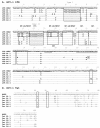Analysis of infectious virus clones from two HIV-1 superinfection cases suggests that the primary strains have lower fitness
- PMID: 20646276
- PMCID: PMC2918528
- DOI: 10.1186/1742-4690-7-60
Analysis of infectious virus clones from two HIV-1 superinfection cases suggests that the primary strains have lower fitness
Abstract
Background: Two HIV-1 positive patients, L and P, participating in the Amsterdam Cohort studies acquired an HIV-1 superinfection within half a year from their primary HIV-1 infection (Jurriaans et al., JAIDS 2008, 47:69-73). The aim of this study was to compare the replicative fitness of the primary and superinfecting HIV-1 strains of both patients. The use of isolate-specific primer sets indicated that the primary and secondary strains co-exist in plasma at all time points after the moment of superinfection.
Results: Biological HIV-1 clones were derived from peripheral blood CD4 + T cells at different time point, and identified as the primary or secondary virus through sequence analysis. Replication competition assays were performed with selected virus pairs in PHA/IL-2 activated peripheral blood mononuclear cells (PBMC's) and analyzed with the Heteroduplex Tracking Assay (HTA) and isolate-specific PCR amplification. In both cases, we found a replicative advantage of the secondary HIV-1 strain over the primary virus. Full-length HIV-1 genomes were sequenced to find possible explanations for the difference in replication capacity. Mutations that could negatively affect viral replication were identified in the primary infecting strains. In patient L, the primary strain has two insertions in the LTR promoter, combined with a mutation in the tat gene that has been associated with decreased replication capacity. The primary HIV-1 strain isolated from patient P has two mutations in the LTR that have been associated with a reduced replication rate. In a luciferase assay, only the LTR from the primary virus of patient P had lower transcriptional activity compared with the superinfecting virus.
Conclusions: These preliminary findings suggest the interesting scenario that superinfection occurs preferentially in patients infected with a relatively attenuated HIV-1 isolate.
Figures







Similar articles
-
HIV controllers suppress viral replication and evolution and prevent disease progression following intersubtype HIV-1 superinfection.AIDS. 2019 Mar 1;33(3):399-410. doi: 10.1097/QAD.0000000000002090. AIDS. 2019. PMID: 30531316
-
A case report of HIV-1 superinfection in an HIV controller leading to loss of viremia control: a retrospective of 10 years of follow-up.BMC Infect Dis. 2019 Jul 5;19(1):588. doi: 10.1186/s12879-019-4229-3. BMC Infect Dis. 2019. PMID: 31277590 Free PMC article.
-
Dynamics of viral evolution and neutralizing antibody response after HIV-1 superinfection.J Virol. 2013 Dec;87(23):12737-44. doi: 10.1128/JVI.02260-13. Epub 2013 Sep 18. J Virol. 2013. PMID: 24049166 Free PMC article.
-
Identifying HIV-1 dual infections.Retrovirology. 2007 Sep 24;4:67. doi: 10.1186/1742-4690-4-67. Retrovirology. 2007. PMID: 17892568 Free PMC article. Review.
-
The Sydney Blood Bank Cohort: implications for viral fitness as a cause of elite control.Curr Opin HIV AIDS. 2011 May;6(3):151-6. doi: 10.1097/COH.0b013e3283454d5b. Curr Opin HIV AIDS. 2011. PMID: 21378562 Review.
Cited by
-
Neutralization sensitivity of HIV-1 subtype B' clinical isolates from former plasma donors in China.Virol J. 2013 Jan 5;10:10. doi: 10.1186/1743-422X-10-10. Virol J. 2013. PMID: 23289760 Free PMC article.
-
A doxycycline-dependent human immunodeficiency virus type 1 replicates in vivo without inducing CD4+ T-cell depletion.J Gen Virol. 2012 Sep;93(Pt 9):2017-2027. doi: 10.1099/vir.0.042796-0. Epub 2012 May 30. J Gen Virol. 2012. PMID: 22647372 Free PMC article.
-
Vaccination with live attenuated simian immunodeficiency virus causes dynamic changes in intestinal CD4+CCR5+ T cells.Retrovirology. 2011 Feb 3;8(1):8. doi: 10.1186/1742-4690-8-8. Retrovirology. 2011. PMID: 21291552 Free PMC article.
-
Immune-mediated attenuation of HIV-1.Future Virol. 2011 Aug;6(8):917-928. doi: 10.2217/fvl.11.68. Future Virol. 2011. PMID: 22393332 Free PMC article.
-
Repressive effect of primary virus replication on superinfection correlated with gut-derived central memory CD4(+) T cells in SHIV-infected Chinese rhesus macaques.PLoS One. 2013 Sep 2;8(9):e72295. doi: 10.1371/journal.pone.0072295. eCollection 2013. PLoS One. 2013. PMID: 24023734 Free PMC article.
References
-
- Quinones-Mateu ME, Arts EJ. Virus fitness: concept, quantification, and application to HIV population dynamics. Curr Top Microbiol Immunol. 2006;299:83–140. full_text. - PubMed
-
- Quinones-Mateu ME, Ball SC, Marozsan AJ, Torre VS, Albright JL, Vanham G, van Der GG, Colebunders RL, Arts EJ. A dual infection/competition assay shows a correlation between ex vivo human immunodeficiency virus type 1 fitness and disease progression. J Virol. 2000;74:9222–9233. doi: 10.1128/JVI.74.19.9222-9233.2000. - DOI - PMC - PubMed
Publication types
MeSH terms
LinkOut - more resources
Full Text Sources
Medical
Research Materials

